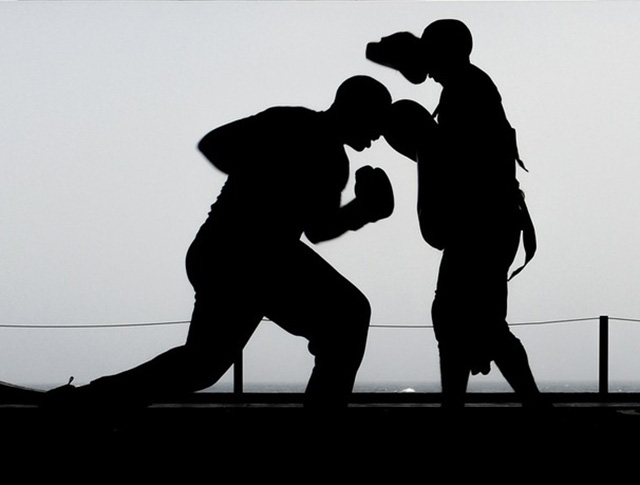Whether you are an aspiring boxing champion or just someone who seeks an intense full-body workout, the following fitness exercises will set you on the way to reaching your boxing goals.
 boxing training
boxing training Professional boxers only step into the ring a couple of times per year. Typically, boxers maintain a good fitness level between fights before ramping up the intensity for several weeks when a battle is upcoming. To maintain their fitness, boxers will then spend a significant time in the boxing gym, fine-tuning their techniques, enhancing core strength, and developing that all-important punching power. They also include sparring sessions, additional conditioning exercises to promote muscle growth and strength, and stretching to aid flexibility.
The main exercises described below are crucial for any boxer, from amateurs to seasoned professionals. It is not only boxers that benefit from incorporating these exercises into their workout regimes, but anyone wanting to improve strength, power, agility, and improve their cardiovascular capacity.
Endurance Workouts
Most boxers start their day with a long morning run to build endurance, as this cardiovascular exercise helps improve their stamina and overall fitness. In addition to running, boxers employ various methods to enhance their endurance. High-intensity interval training (HIIT) is a common practice, involving short bursts of intense activity followed by brief recovery periods. Sparring sessions in the gym simulate the intensity of actual bouts, ensuring boxers can maintain their energy levels throughout a fight. Jump rope exercises can also be done to improve cardiovascular endurance, but have the benefit of also improving coordination and footwork. These multifaceted approaches to endurance training contribute to a boxer's ability to keep up a strong performance in the ring.
Jump Rope Exercises
Jumping rope is not only an excellent way to boost your cardiovascular fitness. Jumping rope or skipping also enhances hand-eye and foot-eye coordination, which is crucial for precise movements in the ring. Skipping also helps with balance and quick footwork. Having immense punching power is worthless if you cannot avoid and evade your opponent in the ring. Some of the world’s greatest-ever boxers were exceptional at not being hit!
Heavy Bag Work
Working with a heavy bag is a staple in a boxer’s training regime. It involves striking a heavy bag to build power, endurance, and technique. Anyone who has seen the famous Rocky movies will remember when Rocky used cuts of beef as a heavy bag because he could not afford an expensive gym membership.
Heavy bag work helps boxers increase their punching power by allowing them to strike with full force. The weighted bag hardly moves even when the strongest boxers hit it, replicating an opponent in the ring.
Hitting the heavy bag does not only help improve punching power but also endurance and stamina. Throwing punches looks easy on television, but throwing punches and having them land on an opponent saps your energy. Top-tier boxers need to be able to throw punches for up to 12 three-minute rounds, so having high upper-body endurance is essential.
Medicine Ball Drills
Athletes from all sports use medicine ball drills thanks to these exercises helping to build core strength and explosive power. In addition, throwing the medicine ball in different ways, such as overhead, underarm, and while twisting, can help simulate movements and forces experienced during a boxing match.
Medicine ball drills are highly effective for strengthening the core, essential for generating power and maintaining balance. Furthermore, having a solid core helps a boxer soak up damage in the ring when they come up against an opponent.
Shadow Boxing
Shadow boxing is a fundamental exercise involving throwing punches and moving around the ring as if to fight an imaginary opponent. It may sound strange, but it allows boxers to perfect their technique, footwork, and defensive maneuvers without being struck by an opponent.
Many fighters shadow box in front of a full-length mirror or have someone record them on film to play back later because the exercise is a superb way to work on your punching form, ensuring your strikes are accurate and powerful.
Shadow boxing improves footwork because you’re moving around as you would in the ring, while all the moving, ducking, diving, and punching is a cardiovascular workout in its own right.
Sparring
Sparring with a partner is the closest thing to a boxing match you can experience without being in an actual fight. It is crucial to always spar under the supervision of a coach or an experienced boxer. In addition, both you and your sparring partner must wear protective gear, including headgear, a mouthguard, and boxing gloves.
The idea is not to try and knock each other out but to apply your skills and learn how to adapt to different opponents’ styles. Start with light, controlled sparring, focusing on defense and technique before gradually increasing the intensity as your skills improve.
Sparring helps build mental resilience and promotes thinking on your feet while under pressure. There is no substitute for stepping into the ring and taking on another human who will do everything possible to evade your punches and land punches of their own.
Related Pages
- Fitness for Boxing
- Testing punching power
- Discussion on the fitness components for boxing, including details of the poll on Fitness components.
- Boxing was rated the World's most demanding sport.
- Fitness for Sports


 Current Events
Current Events